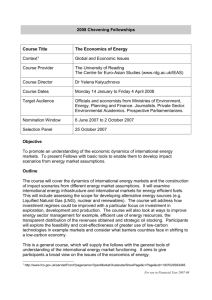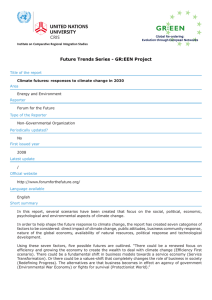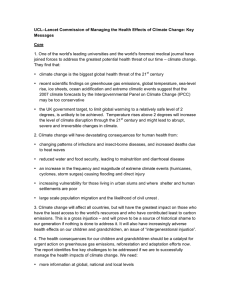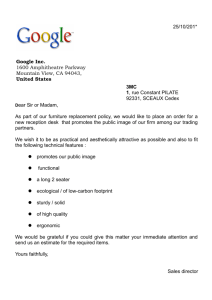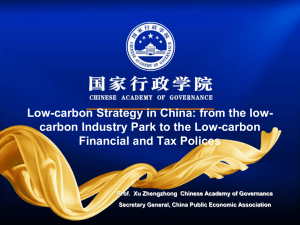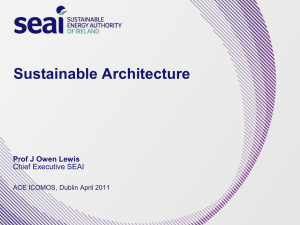Models and Policy System for Low-carbon Economic Development in China Prof. Xu Zhengzhong
advertisement
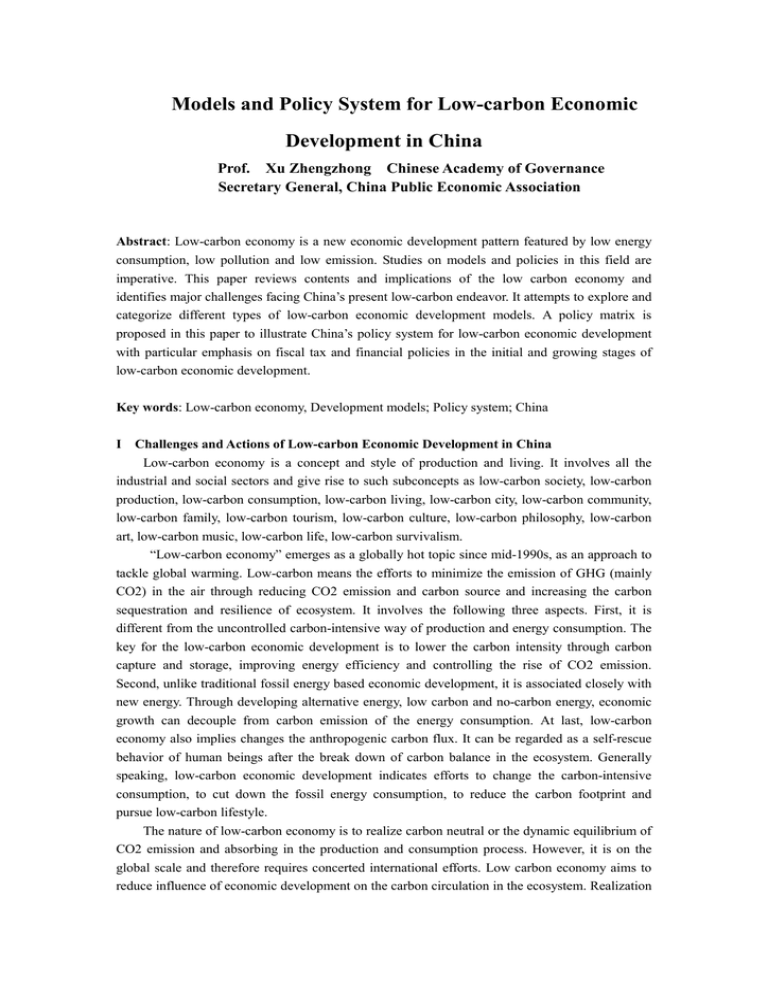
Models and Policy System for Low-carbon Economic Development in China Prof. Xu Zhengzhong Chinese Academy of Governance Secretary General, China Public Economic Association Abstract: Low-carbon economy is a new economic development pattern featured by low energy consumption, low pollution and low emission. Studies on models and policies in this field are imperative. This paper reviews contents and implications of the low carbon economy and identifies major challenges facing China’s present low-carbon endeavor. It attempts to explore and categorize different types of low-carbon economic development models. A policy matrix is proposed in this paper to illustrate China’s policy system for low-carbon economic development with particular emphasis on fiscal tax and financial policies in the initial and growing stages of low-carbon economic development. Key words: Low-carbon economy, Development models; Policy system; China I Challenges and Actions of Low-carbon Economic Development in China Low-carbon economy is a concept and style of production and living. It involves all the industrial and social sectors and give rise to such subconcepts as low-carbon society, low-carbon production, low-carbon consumption, low-carbon living, low-carbon city, low-carbon community, low-carbon family, low-carbon tourism, low-carbon culture, low-carbon philosophy, low-carbon art, low-carbon music, low-carbon life, low-carbon survivalism. “Low-carbon economy” emerges as a globally hot topic since mid-1990s, as an approach to tackle global warming. Low-carbon means the efforts to minimize the emission of GHG (mainly CO2) in the air through reducing CO2 emission and carbon source and increasing the carbon sequestration and resilience of ecosystem. It involves the following three aspects. First, it is different from the uncontrolled carbon-intensive way of production and energy consumption. The key for the low-carbon economic development is to lower the carbon intensity through carbon capture and storage, improving energy efficiency and controlling the rise of CO2 emission. Second, unlike traditional fossil energy based economic development, it is associated closely with new energy. Through developing alternative energy, low carbon and no-carbon energy, economic growth can decouple from carbon emission of the energy consumption. At last, low-carbon economy also implies changes the anthropogenic carbon flux. It can be regarded as a self-rescue behavior of human beings after the break down of carbon balance in the ecosystem. Generally speaking, low-carbon economic development indicates efforts to change the carbon-intensive consumption, to cut down the fossil energy consumption, to reduce the carbon footprint and pursue low-carbon lifestyle. The nature of low-carbon economy is to realize carbon neutral or the dynamic equilibrium of CO2 emission and absorbing in the production and consumption process. However, it is on the global scale and therefore requires concerted international efforts. Low carbon economy aims to reduce influence of economic development on the carbon circulation in the ecosystem. Realization of this target depends largely on the development of low-carbon energy and CMD is also an important part. Future energy should be cleaner, more diversified, and sustainable with higher energy efficiency. International efforts to cope with climate change are generating new waves of innovation in the energy sector. In the final analysis, the long-term GHG emission reduction and sustainable economy development should rely on development of clean and low-carbon energy technologies and adoption of appropriate low-carbon economic growth and social consumption patterns in harmony with environment and climate. 1. China’s Energy Problems and Urgent Energy conservation Tasks China is now embarking on a fast track of economic development, facing pressures from tackling multiple tasks, for instance, to maintain the economic development, eliminate poverty and reduce GHG emission, cope with climate change at the same time. Energy conservation and GHG emission reduction are arduous tasks listed in the 11th five-year plan as environmental protection priorities. Present challenges are as follows: (1) the goal of doubling of China’s GDP meets energy constraint; (2) coal is the largest energy source in China’s energy mix; (3) and the energy mix is hard to be changed. It is estimated that the total demand for primary energy consumption will get to 2.947 billion tons and 4.249 billion tons standard coal in 2020 and 2030 respectively. In the baseline scenario, the demand for primary energy will get to 6.4 billion tons standard coal and CO2 emission will be 3.1 tons in 2050. That is to say China will surpass the USA to become the top CO2 emission country. With implementation of policy measures, the energy demand will be 4.7 billion, a reduction of 27% and the CO2 emission will be 39% lower over the baseline scenario in 2050. China’s is going through the heavy chemical industry stage, transforming through labor intensive to capital intensive development, which indicates GHG emission will continue to rise in the following decades. Tasks of energy conservation and GHG (CO2, SO2, and COD) emission reduction are extremely eminent in China. Coal accounts for the largest share in the energy mix. In the primary energy consumption, the share of coal is over 2/3, while in the world energy mix, petroleum and natural gas are major energy sources. For this reason, China CO2 emission intensity is 30% higher than the world average. In the short run, it is unlikely to get fundamental change in the energy mix and the energy demand and consumption will keep on rising. China’s GHG emission will maintain a uprising trend for a long period of time in the future. China’s present economic development has obvious “high-carbon” feature. Accelerated pace towards industrialization, urbanization, modernization causes rising demand for energy and is accompanied by “development emission”. China’s natural resource endowment with rich coal, scarce gas and oil and lack of high quality energy sources added difficulties to the energy conservation tasks. In additional, the dominant role of second industry in the industry structure also worsens this situation. There is unbalanced development among industries and industries with high energy intensity and high pollution are still taking on a large share. Seeking solutions to tackle these challenges forms the basic tasks in China’s “high-carbon” to “low carbon” transformation. 2. China’s National Actions for Low-carbon Economic Development As the largest developing country in the world, China has upgraded the low-carbon economic development to the national strategic level and adopted series of state actions: 1990-2002 : Began to attach importance to climate change and participate in international efforts Chinese government first sent delegation to the United Nations Framework Convention on Climate Change (UNFCCC) in 1990, and signed UNFCCC in 1992. China signed Kyoto Protocol in 1998 and ratified it in 2002. In the same year, China has integrated the climate issues into the general strategy of constructing “harmonious society and harmonious world” in the 16th CPC National Congress. 2006-2008: Promoting energy conservation and emission reduction. Low-carbon development was first proposed. In March of 2006, the mandatory target to reduce energy consumption per unit of GDP by 20 percent has been set in the 11th five-year plan. At the end of the same year, Ministry of Science and Technology (MOST), China National Meteorological Administration, National Development and Reform Commission, State Environmental Protection Administration jointed publicized National Assessment Report on Climate Change for the first time. In 2007, President Hu Jintao stated in APEC conference that China has decided to pursue the low-carbon economic development. China is one of the earliest developing countries to adopt and implement its own National Climate Chang Program. In this program, the mid-term GHG emission reduction target was set. Through developing new energy, 620 million ton of standard coal is estimated to be saved by the year 2012, equivalent to 1.5 billion ton of GHG emission reduction. This program also proposes several countermeasures to tackle climate change, including shifting economic growth pattern, adjusting economic structure and energy mix, controlling population growth and developing new energy and energy conservation technologies. In October of 2008, a white paper entitled China's Policies and Actions for Addressing Climate Change was published, giving descriptions and introductions of impact of climate change on China and policies, actions, institutional constructions to address climate change issues. Since 2009: Coping with climate change was listed into the main strategic issues for national socioeconomic development. China made official GHG emission reduction commitment. In 2009, 2.1 trillion yuan out of the 4-trillion yuan government stimulus investment was devoted to energy conservation, emission reduction and environmental protection areas. To realize the target of 20% reduction in energy consumption per unit of GDP, priorities were given to nurturing low-carbon economic driving force and developing low-carbon industries, architecture and transportation system. In May of the same year, Chinese government issued official document to implement Bali Roadmap, making clear China’s stance on this issue and its willingness and determination to push forward positive outcomes in the Copenhagen conference. In September 2009, President Hu Jintao illustrated China’s concrete measures to tackle climate change in the United Nations Summit on Climate Change. First, conserve energy and improve energy efficiency and endeavor to cut carbon dioxide emissions per unit of GDP by a notable margin by 2020 from the 2005 level; second, vigorously develop renewable energy and nuclear energy and endeavor to increase the share of non-fossil fuels in primary energy consumption to around 15 percent by 2020; Third, energetically increase forest carbon sink and endeavor to increase of forest coverage by 2020 by 40 million hectares and forest stock volume by 1.3 billion cubic meters by 2020 from the 2005 level; Fourth, step up efforts to develop green economy, low-carbon economy and circular economy and enhance research, development and dissemination of climate-friendly technologies. On 25 November, 2009, Premier Wen Jiabao reiterated in the state council executive meeting the countermeasures put forward by President Hu Jintao in the United Nations Summit on Climate Change. Premier Wen also stated China’s commitment to cutting carbon dioxide emissions per unit of GDP by a 40-45% by 2020 from the 2005 level. It was made clear that tackling climate change should be a major strategy for national economic and social progress. To achieve that, government should take series of measures including increasing input to low-carbon and no-carbon R&D and industries including energy conservation, energy efficiency improvement, clean coal, renewable energy, nuclear energy, carbon capture and restoration; encourage the development of low-carbon industries, buildings and transportation system; formulate supporting laws, regulations and standards improve fiscal, tax, pricing and financial policy measures; improve governance, formulate appropriate regulatory and implementing mechanisms. International cooperation should be strengthened to introduce, digest, and absorb advanced low-carbon and climate-friendly technologies and to strengthen climate change adaptation capacities. In addition, public awareness on climate change should be improved so as to nurture greener life style and consumption models. On 9 March, 2010, China ratified the unbinding “Copenhagen Accord” reached in the United Nationals Climate Conference in December, 2009. The agreement calls for 100 billion aid funds a year to developing countries to deal with climate change and sets targets to prevent Earth average temperature from rising more than two degrees Celsius above pre-industrial levels. Laws and regulations are adopted as important control measures to cope with climate change. China has formulated and amended series of laws and regulations in this regard including Energy Conservation Law, Renewable Energy Law, Laws on Promoting Circular Economy, Laws on Promoting Clean Production, Forest Law, Grassland Law, Regulation of Civil Building Energy Saving. II Low-carbon Development Models in China Low-carbon economic development model involves institutional arrangement, incentives, regulations, development path and instruments. It should comply with production level and regional development strategies. How to select and adopt models will decide China’s low-carbon economic development. 1. Low-carbon Development Models based on Different Driving Forces Based on different driving forces, low carbon development models in China can be categorized as the following eight types: Technology-led model T (Model T). In this model, energy-conservation and emission reduction rely heavily on technological progress and innovation in industries (eg.petroleum, chemistry, electricity, transportation, construction, metallurgy). Technological innovation can lead to clean and efficient utilization of coal, enhancement of added-value of oil gas and coal bed gas, development of renewable and new energies, upgrading of traditional technologies, realization of CO2 capture and storage, etc. Progress of energy-conservation technologies, improvement of the process route, optimization of alternative products, and development of CO2 utilization technologies can provide driving force to low-carbon economy. Project-led mode1 P (Model P). Due to many factors including economic performance, switching costs and path dependence, low carbon economy is difficult to achieve large-scale development in the short run. However, projects (eg. wind power project and waste treatment project) with particular objectives, timetable, inputs, outputs and outcomes can serve as platforms and carriers for low-carbon economic development. Enterprise-led models (Model E) Enterprises are major players in the economic development. Without their participation, low-carbon economic cannot take roots in China. In this model, the leading enterprises in low-carbon economic development will lead to organizational evolution of industries; stimulate dissimilation of low-carbon technologies among enterprises. With good management and institutional innovation, low-carbon technologies can also spillover within and outside industries and finally realize the overall development of low-carbon economy. Non-governmental organizations-led model (Model N) Non-government organizations refer to social organizations that exist between governments and markets, representing interests of particular communities, classes and groups. They are playing more and more important roles in promoting low-carbon economy. Capital-driven model (model C) “Carbon trade” marked the global green trend in the traditional way of production. It is based on the economic theory of Coase Theorem, that treatment of GHG (represented by CO2) will cause differences in enterprise costs. Since exchange of commodities can be regarded as trade for some (property) rights, the discharge right of GHG can also be exchanged. Carbon trade is proved to be the most effective solution to pollution under the market framework. Therefore, China should actively participate in the construction of global carbon market. Meanwhile, it should also take good use of the financial market, giving full play to capitals in the resource allocation, channeling funds and technologies to the low-carbon sectors. Consume-guide model (Model C) Without undermining the quality of life of people, there is still huge potential of energy-conservation and emission reduction in the consumption sector. Take the energy-saving building for example. Civil building energy consumption accounts for 20.71% of the total energy consumptions of China. 10-15% of total output of coal is used for warming buildings and rural living and 25-30% of electricity is used for construction and house living (cooking, lighting, home electrical appliance). By the year of 2020, urban residence will get to 56% of the population and 110 x 108 square meters’ building will be constructed. The purpose for building and living energy saving is to lower the consumption of fossil energy. Feasible measures including improving the warming system of buildings, utilization of solar power, promoting the use of energy-saving bulbs, etc. Government-driven model (Model G) Government plays important roles in pushing the development of low carbon economy. Experience of some developed countries has showed that through enforcing powerful regulations and economic measures, low-carbon economy can realize fast development in a short period of time and yield apparent social and economic benefits. Legally-bound model (Model L) In this model, government may set minimum energy permission standard and discharge permission standards through legislation and law enforcement to promote the development of low carbon economy. This model is featured by authoritative, open and stable practices. For example, minimum energy efficiency permission standards for vehicles and most home electrical appliance have been set in the US and energy standards for building materials and some high energy-consuming home appliances (eg. air-conditioner and refrigerator) are becoming more and more rigid. British government has formulated sustainable house standards. These standards are divided into six levels and prescribed the minimum energy efficiency and water efficiency. All buildings for rent and sales have to get energy efficiency certificates. 2. Low-carbon Economy Models Based on Different Targets According to different targets, there are low-carbon city model, low-carbon industry model and carbon sequestration model. Low-carbon city model aims to maximally improve the utilization efficiency of resources and energies and reduce the discharge of GHG emission through advancing low-carbon technology and institutional innovation, cultivating low-carbon lifestyle on the city scale. This model will give rise to resource-intensive, environmental-friendly and social harmonious socioeconomic operation and health, thrifty, and low-carbon lifestyle and consumption. The final objective is to achieve high-efficient, low-carbon and sustainable development of cities. Low-carbon city model demonstrates the following three features. First, it seeks to change the urban energy supply from source to transform the energy consumption from high-carbon to low-carbon or no-carbon. Second, in terms of economic development, it gives emphasis to low-carbon production, adjustment of industrial structure. Development of high-carbon industries is strictly controlled and low-carbon lifestyle and consumption habits are advocated. This model suits regions mainly composed by cities. For instance, Shanghai has set and is now moving towards its eco-city target. It aims to become a modern eco-city with coordinated development of economy and society and harmonious relationship between human and environment. Low-carbon industry model functions mainly through low-carbon Industrial Parks. There are two typical routes. The first is based on circular economy and clean production. It attempts to build eco-industry parks that enable cycling and reuse of resources and wastes so as to reduce carbon and energy consumption. Many industrial parks of this type have been constructed throughout China, including Guigang National Eco-industrial Demonstration Park, Tianjing Economic, Science and Technology National Eco-industry Demonstration Park, Nanhai National Eco-industrial Park, Rizhao Eco-industrial Park in Shangdong Province, Baotou National Eco-industrial Demonstration Park in Inner Mongalia, etc. picture 1 and picture 2 give illustrations to the eco- industry chain and eco-economic system of MELICSEA High-tech Industrial Park. The second route pursues coordinated development of second and tertiary industries. It attempts to improve the share of tertiary industry in the economy and advocates development of low-carbon industries (eg, tourism). For the second industry, it vigorously promotes high-tech industries and transformation and upgrading of traditional labor-intensive and manufacturing enterprises. High and new technologies, especially low-carbon technologies pillar the whole industrial system. New material, new energy, new technologies should be given priorities to attract investments. Moderately development of tourism, adjustment and optimization of industry structures are important tasks in this route. Generally speaking, low-carbon economic development under this model highlights improvement of energy efficiency and reduction of pollutant ( eg.CO2) through R&D, product and process upgrading, adoption and application of advanced equipment and technologies as well as integration of technologies, etc. Figure 1 Low-Carbon Industrial Chain of MELICSEA Aeolian ① Kiln exhaust gas CO2 degradable plastics Limestone ④ Fly ash ② Nano CaCO3 PVC profile ③ ⑤ Gangue Paint Gangue Power Coal Hard coke Kaolin Fly ash Calcium silicate slag Limestone ⑥ ① cement ④CO2 Figure 2 ② Coal stove Sewage ⑤ Real estate Low-carbon Economic System of MELICSEA ③ kiln exhaust gas ⑥ Alumina Eco-system Waste gas Waste gas Economic system Electricity Heating Recycled water Waste residue Ash Waste Water Gangue Fly Ash Sewage Treatment Heat MELICSEA Thermal power stations Inflammable Waste Electricit Domestic water Aeolian Low-carbon economic development should not only seek carbon emission reduction from the source, but also try to improve carbon sequestration. Therefore, the carbon sequestration model provides an effective approach. Unremitting Eco-construction, development of eco-agriculture, reforestation efforts can contribute to higher storage of air GHG in the eco-carbon sink, which can be absorbed and fixed by plants and soil . Practical measures under this model include reforestation, grassland restoration, wetland and field protection, etc. However, this model is at the influence of natural conditions. Forestry management, improving per unit yield and forestation are at high costs. This model is suitable for areas with good agricultural and forest conditions. 3. Low-carbon Economy Models Based on Different Leading Agents Based on different leading agents, low-carbon economic development models can be categorized as top-down model and bottom-up model. The former is usually led by government and pushed forward by establishing institutions and mechanisms that could create favorable political, legal and market environment for the development of low-carbon economy. Governments’ leading role in the model can improve the public awareness and encourage low-carbon investment and consumption. This model features high efficiency and authoritative credits. But sometimes there is gap between model and regional development. Therefore, it suits the primary and developing stages of low carbon economy. The bottom-up model is usually led by NGOs, combining efforts of enterprises, social communities and government. This model gives consideration of the leading role of market and public opinions on environment and low-carbon issues. Compared with the former model, this type is less efficient. It requires NGOs that has good understanding of the low-carbon economy and can balance or even sacrifice their own interests for the national long term interests. III Policy Systems for Low-Carbon Economic Development in China Low-carbon economy is a new economic development pattern based on low energy intensity, low pollution and low emission. It integrates low-carbon industries, technologies and lifestyles. The crux for its development is to develop new energy, improve energy-using efficiency and establish green GDP. Technological innovation in the energy sector, institutional innovation and shifts in the mode of thought are core issues. Low-carbon economy covers low-carbon production, low-carbon circulation, low carbon distribution and low-carbon consumption. Based on China’s practical condition and experience, the following part proposes a policy matrix for low-carbon development (see picture 3). 1. Construction of Low-Carbon Economic Policy Chain The low-carbon economic development policies can be divided vertically into overall strategy, basic policies and implementing policies. Overall strategy refers to the macro-level central plan and outlook for the low-carbon economic development. It sets tunes and guiding principles. Basic policies refer to general policies within a particular sector. They give policy guidance within the sector and sustain the implementing policies. For instance, the energy policy is assembly of all the low-carbon policies within the energy sector. Implementing policies are practical measures under the basic policy. For example, energy policy can be specified into new energy policy, energy mix policy, energy conservation and emission reduction policy. Implementing policies should be feasible enough to be implemented. Throughout the chain, fiscal policy, tax policy and financial policy plays extremely important roles. Fiscal and tax policies give impetus to start low-carbon economy and financial policies provide it with continuing momentum. Basic policies are closely connected, shaping the first horizontal policy chain. The second horizontal policy chain is composed of all the implementing policies. Institutional and cultural factors are merged into the layers between basic and implementing policies and internalized as core elements. Low-carbon Economic Development Strategies Policy Core Low-carbon System Low-carbon Culture Horizontal Basic Policy Chain Energy Industry Market Consumption Technology Management Policy Policy Policy Policy Policy Policy New energy Emerging Industry Market access Consumption Guidance New energy Technology Energy structure Industry structure Carbon exchange Consumption environment Energy Low-carbon agriculture Low-carbon tax and finance Consumption emission reduction Low-carbon incentives Low-carbon industry policy Eco-compensation Green Consumption Carbon absorption Low-carbon control Low-carbon service industry Eco-financial Policy Low-carbon lifestyle Technical cooperation Low-carbon pilot High energy efficiency Energy conservation Emission reduction and Demand Low-carbon price Low carbon energy conservation Energy Contract and Low-carbon evaluation Technical Standard Horizontal Implementing Policy Chain Tax and fiscal policies provide the starting power Policy Base Financial innovation provides continuous momentum Figure 3 Policy Chain of Low-carbon Economic Development in China 2. Fiscal Policy Infuse Power to Start Low-Carbon Economy First, government should establish a green budget system and increase input for low-carbon development. Theories and international experience show that efforts for energy-conservation, carbon emission reduction, development and utilization of new and renewable energy are usually non-profit and therefore should be priorities of government investment. Current budget system should be adjusted and reformed to reflect this trend. Government present investment to the R&D of energy conservation and emission reduction technologies, new and renewable energies are unstable without independent and special program funding support. Industrial investments in these areas are usually distributed to technical upgrading and high-tech innovation programs. Government direct investments are only in the R&D and production (for technical upgrading) sectors. There is investment vacuum in the dissemination, application, distribution, service, recycling, information sharing of new energy and low-carbon products. One the one hand, environmental expenditure items should be adjusted in the regular budget to over CO2 emission reductions and those efforts related to energy conservation, new and renewable energies or combine these items as the “environment and energy” expenditure. Budget should be allocated to low-carbon technology R&D, dissemination and training. On the other hand, governments should strengthen financial support for low-carbon development in their program budget to vigorously advance R&D of new energy technologies including wind power, solar power, biomass, clean coal utilization, nuclear power, intellectual electric grid, new energy car, etc. Input to fossil fuel utilization so as to optimize energy mix. The low-carbon upgrading of traditional industry, for example the technical improvement of fire power plant to build CO2 capture and storage capacities should be intensified. Secondly, tax reform should be introduced to formulate more preferential policies and amplify tax functions in low-carbon economy development. In view of the urgent energy conservation and emission reductions targets and unfavorable international environment, green-transformation of tax regime can be approached by integrating current tax categories and adjusting certain tax elements related to energy conservation, carbon emission reduction and development of new and renewable energies to minimize the impact on tax payers in the short run (see table 1). While in the long run, new taxes such as carbon tax, carbon tariff, environmental protection tax and energy tax can be introduced after comprehensive consideration of economic development and energy mix. Tax reduction is the major preferential policy for low-carbon economic development in China. Others measures including investment tax credit, tax refund of re-investment、accelerated depreciation, tax deferral etc., have not been applied yet. The strength and coverage of preferential tax policies should be upgraded and more diversified measures should be applied to encourage low-carbon investment, production, consumption, technology extension, etc. These measures should pursue the progress of new technology and energym, while protect the core competitiveness of enterprises. Table 1 Tax Adjustment Schemes for Low-carbon Economic Development Tax Category Resource tax Adjustment (1)Enlarge taxation scope to cover to resources, such as land, sea, forest, geothermal resource, etc. (2)Appropriately Increase tax rates of some resource taxes, especially for these that are under key protection and are prohibited in exploitation. (3)Adjust current tax base. Eg. Output-based assessment should be replaced by recoverable reserves to encourage resource recovering. Consumption tax (1)Enlarge taxation scope to cover products that are with high energy consumption and high carbon emissions and fail to meet energy conservation standards. (2)Develop differentiated tax rate. Tax rate should be based on energy consumption and carbon emission. Current tax level of some consumer goods need to be adjusted, Eg increase the tax rate of high-emission cars, while lower that of low-emission cars and motorcycles (3)Consider collecting oil consumption tax to improve public awareness on energy serving and environmental protection. Value-added tax(VAT) (1)Offer VAT deduction to key energy-saving equipment and products to remove their price constraints within a given period of time. (2)Remove tax reduction on toxic pesticide and agricultural plastic film. business tax (1) Exempt business tax of institutes, organizations and individuals that get incomes from technical transfer, consultation, and service in energy-saving, emission reduction, renewable energies R&D to encourage the dissemination and utilization of energy-saving technologies. income tax (1) Increase the pre-tax deduction rate of R&D funds for energy-saving equipment and products (2) Apply the accelerated depreciation to some special equipment for producing energy-saving products. (3) Deduct or exempt income taxes of enterprises that purchased and installed equipment for producing energy saving products. (4)Exempt or reduce income tax of institutes and individuals who receive income from low-carbon oriented technical services including technical transfer, training, consultation, service, and outsourcing. tax on buying (1) Give appropriate tax preference to clean energy or new energy vehicles. vehicles vehicle vessel tax tariff and (1) Adjust the base of vehicle and vessel tax. There should be different threshold for vehicle and vessels with different energy consumption levels and gas emission. (1)Impose tariff or environmental tariff on imported equipment with high energy consumption and carbon emission. (2) Impose tariff or environmental tariff on primary or semi-manufactured goods which consume large amount of domestic natural resources and cause little or no pollution in the destination countries. At last, we should integrate and coordinate relevant policies, intensify institutional innovation to amplify the function of fiscal and tax policies. Low carbon economy is closely related to economy, society, energy and environment. So low-carbon economic policy should be a comprehensive system to include all these factors and there should be rigorous laws and powerful policy measures to ensure its implementation. Firstly, in terms of government expenditure, financial subsidies should play more important roles in technical upgrading and innovation, energy-saving consumption and R&D of renewable energy. Current financial subsides are mainly focus on direct financial support for program R&D and technical upgrading for energy conservation and emission reduction. In the future, subsides should be extended to cover producers, sellers and consumers. Secondly, we should establish a sound government procurement system, giving considerations to energy saving and CO2 emission reduction. The purchased products should get rigorous energy certification. Thirdly, we should set the agenda to establish a special carbon fund, although time is still immature to implement it at present. Before carbon tax is set in place, the major funding source is from the carbon emission trading. However, carbon tax should be collected as the major funding source once the opportunity is mature. This fund should be used to support the improvement of energy efficiency, technical innovations for energy conservations, development of alternative energies and forestation, etc. At last, we should set up carbon trading system and pricing mechanisms to effectively control the CO2 emission especially in high-carbon emission sectors (coal, steel and nonferrous metals). 3. Financial policies provide continuing momentum for Low-carbon Economic Development Financial industry should embrace innovations integrating climate change and low-carbon elements to produce continuing momentum for low-carbon economy in China. China should full play of its late-developing advantages, drawing on experiences from international carbon trading market and catastrophe bond market. It should make strategic plans and push forward its own financial innovation in line with the national economic progress and financial market reform. Firstly, commercial banks in China should establish supporting system for the low carbon economy as soon as possible. Prevailing norms and principles concerning sustainable development, such as the equator principle should be set in place and observed. Commercial banks should provide more “energy efficiency loans” to support low-carbon projects. Current priorities should focus on energy-efficiency management in such sector as energy-conservation facilities of architectures and transportation, then the renewable energy sectors, including biomass, wind power, solar power, hydropower, and fuel battery. Commercial banks should actively promote low-carbon investment products. Prevailing international practice is to set up carbon-neutral fund to make investment in low-carbon project and participate in the exchange of financial derivatives such as carbon credits and catastrophe bond. Chinese commercial banks could continue its efforts to set up funds related to the performance of low-carbon and environmental friendly enterprises so that investors can directly follow their performance in the market. Second, a national carbon exchange management platform should be set up to integrate all the carbon exchange markets. For recent years, CMD market, which is second largest in China’s carbon exchange market, occupies the dominant position with a market share of 84%. Despite its huge carbon reduction potential, China is still in the bottom of price chain in the global carbon market. Therefore, the key for developing carbon exchange market is not to set environmental exchanges throughout the county, but to set up a national level carbon exchange management platform to provide supply-and-demand information, to link prices in local environmental exchanges, and to collect information about the progress of annual target. Finally, a multi-layer carbon exchange market consisting of national-level carbon exchange management platform and local carbon exchange market should be set up. Third, Chinese government should issue catastrophe bonds in the international market. In face of more frequent natural disasters in China, insurance company, especially some re-insurance companies are facing more heavy payment pressure due to large volume of direct economic losses. Issuing catastrophe bonds is one of the most effective ways for risk transfer and sharing. However, domestic market flow and market volume of these bonds in China are quite limited and relevant regulating laws for their issuing and investment are not in place yet. Chinese government could draw on experience from Mexican practices to issue catastrophe bond in the international market in cooperation with sales agent like Swiss Reinsurance Company. Forth, incentive mechanisms for low-carbon economic development should be installed in the financial sector. There are two approaches to achieve that end. One is to stimulate innate innovative initiatives of financial institutions by establishing innovation performance evaluation system, double-ladder incentive system and so on. The other is to create sound policy supporting system through legislation and talent development. Major incentive measures include tariff reduction for CDM projects, appropriately extending tax exemption, giving preferential income tax to financial institutions that support low-carbon innovation; offering interest subsidy to commercial banks that fund low-carbon development; Intensifying regular trainings for employees in financial sector to create good learning environment and cultivate more rational talent structure. In addition, current human resource management system, performance evaluation system and distribution system should be adjusted to create an favorable environment for nurturing, discovering, attracting and retaining talents in the this industry. Fifth, financial risk preventing mechanisms for low-carbon economy should be improved. On the one hand, to prevent the potential risks in the path of innovation, financial institutions should formulate risk preventing and controlling measures within their governance structure and management system. Based on characteristics of their new products and business operation and comprehensive analysis of potential risks and weak points, risk preventing and control measures should be more targeted. On the other hand, regulators should make constant improvement in their financial regulatory system, extending the regulatory scope and innovating regulatory instruments. They should attach importance to risk preventing in business innovation of financial sector, strengthen the information disclosure to create a favorable outer environment for preventing financial risks. Meanwhile, macro-information sharing and pre-warning mechanisms should set in place to avoid the regulatory vacuum and blind pot. References: [1] David J. Cummins, Richard D. Phillips. Applications of Financial Pricing Models in Property Liability Insurance[M]. The Handbook of Insurance Economics, Boston: Kluwer Academic Publishers, 1999. [2] Douglas G. Cogan. Corporate Governance and Climate Change: The Banking Sector[J]. A Ceres Report, January, 2008. [3] GC Securities. The Catastrophe Bond Market at Year-End 2007, April, 2008. [4] Zhang Kunmin, et al. Low-carbon Economics[M]. Beijing: China Environmental Science Press, 2008: 21,97,127,379,513. [5] Xie Junan, Hao Dongheng, Xie Wen. Ieas and Countermeasures for Low-canbon Economy Development in China[M]. Modern Economics and Management, 2008,30(12):1-8. [6] Wang Yan, Yang Zhi. Progress, Challenges and Opportunities of Low-canbon Economy Development[J]. Scientific Management Research, 2010, 28(5):106-111. [7] Li Wujun, Huang Binnan, Policy Research on Low-carbon Economy Based on Policy Chain Paradigm[J]. Academic Jourmal of Zhongzhou, 2010,(5):35-38. [8] He Pingjun. International Experience and Enlightenments on Fiscal Policies for promoting Low-carbon Economy Development[J]. Reformation and Strategy, 2010, (10):187-190. [9] Wang Huitong. Research on Establishing Fiancial Innovative Mechanism for Low-carbon Economy[J]. Finance and Economics, 2010, (7): 35-39. [10] Zhuang Guiyang. Analysis on Approaches and Potential for Low-carbon Economy’s Development in China[J]. Studies in International Technonlogy and Economy, 2005, 8(3). [11] Hou Junqi. Research on Low-carbon Economy Development Model[J]. the World of Survey and Research, 2010. [12] Yang Shuxia, Tang Mingrun. Choices for Regional Low-carbon Economy Development Model in China[J]. Journal of China National School of Adinimistration, 2010, (5): 43-46.
